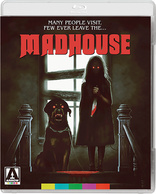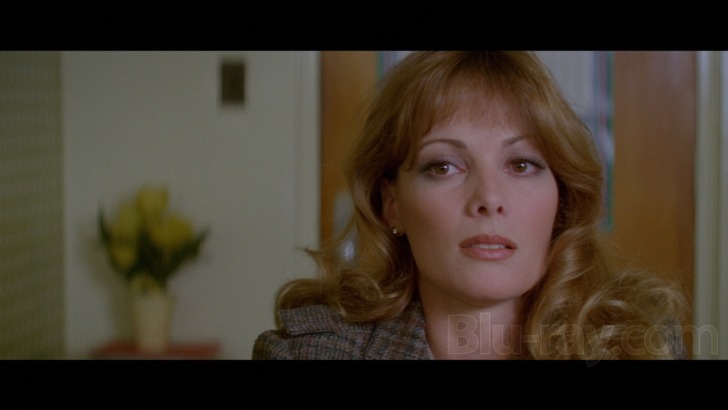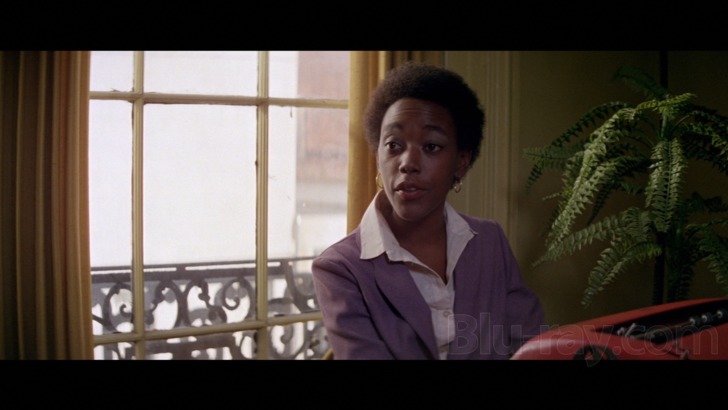Madhouse Blu-ray Movie
HomeMadhouse Blu-ray Movie 
There Was a Little Girl / And When She Was Bad / Flesh and the Beast / Scared to Death / Blu-ray + DVDArrow | 1981 | 93 min | Not rated | Jun 13, 2017

Movie rating
6.3 | / 10 |
Blu-ray rating
| Users | 0.0 | |
| Reviewer | 3.0 | |
| Overall | 3.0 |
Overview
Madhouse (1981)
Julia, a teacher in a school for the deaf, has a hideosly disformed and deranged twin sister that resides in the local looney bin. She escapes to gate-crash a surprise birthday party for Julia by murdering all the party guests with the help of a giant killer Alsation dog, which gets it's come-uppance when lobotomised by a power drill, in a scene that will offend most animal lovers.
Starring: Trish Everly, Michael MacRae, Dennis Robertson, Morgan Most, Allison BiggersDirector: Ovidio G. Assonitis
| Horror | 100% |
Specifications
Video
Video codec: MPEG-4 AVC
Video resolution: 1080p
Aspect ratio: 2.36:1
Original aspect ratio: 2.35:1
Audio
English: LPCM 2.0 (48kHz, 16-bit)
English: DTS-HD Master Audio 5.1 (48kHz, 24-bit)
BDInfo
Subtitles
English SDH
Discs
Blu-ray Disc
Two-disc set (1 BD, 1 DVD)
DVD copy
Playback
Region A (B, C untested)
Review
Rating summary
| Movie | 2.5 | |
| Video | 4.0 | |
| Audio | 4.0 | |
| Extras | 2.5 | |
| Overall | 3.0 |
Madhouse Blu-ray Movie Review
Reviewed by Jeffrey Kauffman June 13, 2017Slasher films with relatively small casts end up offering a limited guessing game for those viewers who are prone to try to figure who exactly is the “secret” bad guy (or girl). Despite some valiant attempts at misdirection, there are only so many possibilities that Madhouse (originally released as There Was a Little Girl) proffers, and so both early and late revelations as to who is responsible for the accruing body count may not provide much in the way of shock value, especially since the film pretty much gives away at least part of the "mystery" surprisingly swiftly. That, combined with what now look like almost quaint (if sometimes graphic) special effects, may lead some to wonder why exactly this film was labeled as a so-called “video nasty”, though there’s no denying that some of the on screen carnage is at least potentially disturbing. That is the case with the bizarre vignette that opens the film, which sees two (twin?) girls playing, with one of the them suddenly pummeling the other one with a brick, leading to some massive facial disfigurations. But here’s just one place where Madhouse may in fact start to drive viewers (or at least reviewers) crazy: what exactly does this scene have to do with the actual plot? The main part of the feature focuses on grown woman Julia (Trish Everly), who is an attractive blonde who commendably works with deaf children in Georgia (more about that in a moment). Julia’s harridan and obviously unhinged sister Mary (Allison Biggers) is confined to either a mental institution or some kind of hospital (Madhouse is not especially strong on clear exposition at times), but she (i.e., Mary) has a horribly disfigured face, which would lead one to believe that the opening vignette was documenting Julia attacking Mary. The film, however, instead suggests that Mary had been the sadistic child and that Julia is still dealing with years of trauma as a result of her childhood horrors at the hands of her sister. And so already Madhouse is potentially a little confusing, at least for those who actually think about it. For those willing to simply go along for the ride, the film does in fact provide some gory death scenes and a completely over the top denouement that may remind some of Happy Birthday to Me, another 1981 slasher entry that also fell sway to the video nasty “epidemic” in the United Kingdom.

The use of what appear to be real life deaf (or at least hearing impaired) children in Madhouse may remind some of a similar use of disabled folks in The Sentinel, something that some may find at least potentially offensive. That said, the brief scenes documenting Julia teaching the kids how to speak are in fact rather touching and give this slasher film a rather uniquely authentic feeling, though of course this plot element has little to do with the blood and guts that are about to spill across the screen, often in almost gonzo ways. (Perhaps the film's most shocking death, one that is thankfully not shown on screen, actually involves one of the children.) For reasons that are again left largely unexplained, Father James (Dennis Roberston) encourages Julia to visit Mary on her birthday, something that unsurprisingly doesn’t go especially well, leading the seemingly bedridden Mary to threaten Julia with the same kind of horrors Mary has been living with (in an allusion that may refer either to Mary’s disfigurement or to that long ago pummeling, which again probably raises more questions than it answers).
The main part of the film of course details a largely unseen assailant who takes out an aggregation of folks surrounding Julia, often with the help of a vicious Rottweiler, in another plot element which supposedly harkens back to Julia’s childhood, but which is never properly contextualized, and so admittedly provides jolts, but without any real emotional content. The cast of suspects includes the aforementioned Mary and Father James, but also potentially includes Julia’s boyfriend Sam (Michael Macrae), who rather helpfully has a background in mental health. A couple of other supporting characters never truly penetrate into full "suspect mode" either due to their obviously tangential relationship to the story or (kind of ironically) by meeting their gruesome fates at the jaws of the almost feral canine. Julia is (in true damsel in distress mode) convinced someone is out to get her, which is more than obvious to the viewer, but in typical fashion, she’s surrounded by people who keep insisting she’s imagining things.
Madhouse is kind of a study in contrasts, at least within the context of slasher films in general and Italian horror in particular. First of all, the film was shot in the United States, and features an English language cast, and so there’s relatively little of the surreality that often attends Italian productions due to being both dubbed and completely post-looped, though according to some of the technical notes included with this release (see the video section below), the film evidently was post-looped. But perhaps even more interestingly, Madhouse is (not to pun too horribly) a cut above the traditional slasher offering in terms of production values and filming style. Few would probably place co-writer and director Ovidio G. Assonitis at the head of the Italian horror helming class, but he stages things rather effectively here, and with some evocative lensing by his frequent collaborator cinematographer Roberto D’Ettorre Piazzoli, Assonitis provides a suitably spooky ambience that at least intermittently helps the film overcome some of its narrative lurches and a few elements that almost play like Grand Guignol performed by a carnival troupe.
Madhouse Blu-ray Movie, Video Quality 

Madhouse is presented on Blu-ray courtesy of Arrow Video with an AVC encoded 1080p transfer in 2.36:1. Arrow's insert booklet provides the following information on the transfer:
Madhouse was exclusively restored by Arrow Films and is presented in its original aspect ratio of 2.35:1 with 5.1 and 2.0 stereo sound.This is by and large a great looking transfer, one with nicely saturated levels of what is at times a pretty overamped palette, especially in some of the gore scenes. Bright daylight scenes reveal excellent fine detail levels on things like fabrics in costumes and even some of the foliage in outdoor locations, though even these scenes can look slightly diffused and relatively soft (the lighting regimens in this film are quite interesting and almost glossy looking at times). There are some recurrent issues with detail in the many dark scenes, and grain can also tend to look a little chunky at times in these moments as well. There is one especially graphic scene involving the dog that is considerably grainier and softer looking than the bulk of the film, and I'm assuming perhaps it was edited out at some point and needed to be restored from some sort of duplicate element.
The original 35mm camera negative was scanned in 2K resolution at Eurolab, Rome. The film was graded and restored on the Nucoda grading system at R3store Studios, London. Thousands of instances of dirt, debris, scratches and other instances of film wear were repaired or removed through a combination of digital restoration tools and techniques.
The original English language 4-track stereo mix was transferred from the original Dolby mag reels and has been newly remastered to 5.1 at L'Immagine Ritrovata, Bologna. There are instances throughout the film in which the audio synchorinsation will appear slightly loose against the picture, due to the fact that the soundtrack was recorded in post-production.
Madhouse Blu-ray Movie, Audio Quality 

Madhouse features LPCM 2.0 and DTS-HD Master Audio 5.1 tracks, as described above in the video section. The film benefits from a rather evocative score by the typically wonderful Riz Ortolani ("More" from Mondo Cane , "Forget Domani" from The Yellow Rolls-Royce), which makes spooky use of an old lullaby. The surround track splays some of Ortolani's score arguably a bit more effectively than the 2.0 track, and there are also isolated moments of discrete channelization for various sound effects, but surround activity is somewhat limited on the 5.1 track, and frankly you're not missing much if anything by going with the film's original audio presentation. Dialogue is rendered cleanly and clearly on both tracks, and there are no problems with distortion, dropouts or other damage.
Madhouse Blu-ray Movie, Special Features and Extras 

- Audio Commentary with The Hysteria Continues
- Running the Madhouse (1080p; 12:40) is an interview with Georgia actress Edith Ivey, who seems incredulous that anyone even knows about, let alone cares about, this film.
- Framing Fear (1080p; 19:32) is a 2017 interview with cinematographer Roberto D'Ettorre Piazzoli. In Italian with English subtitles.
- Ovidio Nasty (1080p; 7:44) is an interesting if fairly brief interview with Ovidio Assonitis, who discusses some almost metaphysical aspects he sees in the film, along with some ostensibly more mundane material like information about Riz Ortolani.
- Alternative Opening Titles (1080p; 3:01) offers the credits sequence featuring the title There Was a Little Girl.
- Original Trailer (1080p; 3:04)
Madhouse Blu-ray Movie, Overall Score and Recommendation 

Madhouse has an undeniable mood, and it's surprisingly well shot for such an otherwise lo-fi effort, but it has too many culprits, include of the canine variety, as well as several story elements that frankly don't make much sense. This is another cult release that will certainly appeal to genre aficionados, and as usual Arrow has provided excellent technical merits and some winning supplements.
Similar titles
Similar titles you might also like

The Slayer
1982

The Mutilator
1985

Censor
2021

Blood Rage
1987

Slugs
Slugs, muerte viscosa
1988

Dementia 13
Director's Cut
1963

Evil Ed
Special Edition
1995

Microwave Massacre
1983

Cat in the Brain
Un gatto nel cervello | Glow in the Dark Cover & Mini Portrait of Lucio Fulci Limited Edition to 3000
1990

Madman
1981

Terror
1978

The Night Evelyn Came Out of the Grave
La notte che Evelyn uscì dalla tomba
1971

Death Spa
1989

The Burning 4K
Collector's Edition
1981

The Driller Killer
1979

Blood Harvest
1987

The Initiation
1984

Anthropophagous
1980

Trauma
Dario Argento's Trauma | Standard Edition
1993

Strait-Jacket
1964